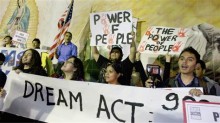Over 65,000 undocumented students graduate from high school each year in the United States; these are students who do not have legal status to reside in the U.S. and face the burden of an unequal access to education. Undocumented persons or unauthorized persons are individuals who came to the U.S. without authorization, or came with the proper documentation but remained in the U.S. Many of these students were brought from their home countries at a very young age, some within the first few years of being born. These students come from family backgrounds of hard-working families who decided to come to the United States to achieve the American dream.
The federal DREAM Act (Development, Relief and Education of Alien Minors Act) is a legislation that would grant a path to citizenship for unauthorized students 1) who entered the U.S. before the age of 16, 2) resided in the U.S. 5 years prior to the enactment of the bill, 3) graduated from a high school in the U.S. or attained the equivalent of a high school diploma, or got accepted to a college institution, 4) at the time of the application must be between 12-34 years old, 5) demonstrate good moral character. The federal DREAM Act was first introduced in the senate in 2001, and has been reintroduced several times since then. The last time that came to a vote was during the lame duck session on December 18, 2010, in which the vote resulted in 55-41 with many Democrats voting against the bill. It was a great defeat for those who would benefit from the bill and those who stood in support. On May 11, 2011 Sen. Dick Durbin reintroduced the federal DREAM Act.
This movement reminds me of the Chicano movement because it takes committed people who deeply care about this issue. It is closely associated with a comprehensive humane immigration reform for unauthorized immigrants who have been contributors to the U.S. through their hard labor, and who many times are exploited by the cruel system. Within the Chicano movement, there existed the division between Chicana feminists who proclaimed equality, and those who did not see sexism as something to challenge within the movement. I experienced a similar issue in 2010 when I attended a 3-day conference along with other members of the student organization on campus (LMU RESILIENCE) to discuss our involvement with student groups from other campuses throughout California.
The conference was led by the hosting group at UC Santa Cruz and the leader of CHIRLA‘s CA Dream Network. The second day of the retreat, we were asked what 2010’s immigration campaign should focus on: mobilizing for the passing of the federal DREAM Act or mobilizing for a Comprehensive Immigration Reform. Student club organizations from various college institutions from all over California were being represented by 5 members. When the time came to vote on what issue to focus on, there was great division between the participants. We were torn between voting for the DREAM Act because this would only benefit students achieving a college degree (but we saw a greater chance of winning), and the Comprehensive Immigration Reform would include the students and families (but we also felt it would be a lot harder to achieve). The organizers of the retreat had to meet separately during dinner time because it seemed that their next day’s activities would have to change since many participants were still discussing the issue and we couldn’t come to a consensus.
By the end of the conference we were suppose to come up with a campaign plan and ready to mobilize our constituents at our campuses, but we had to take Sunday to come together as a group and bring to the table the tensions that were happening. Unlike the 1971 Conferencia de Mujeres por la Raza in Houston, Texas, nobody walked out. But the time that was set aside on Sunday to discuss the issue did help the organizing because many students expressed their feelings and their fears. More than 3/4ths of the participants, if not all, cried and demonstrated support. We were all in this together and we decided that the only way we could solve the issue was through conversation.
That year, many students, as it still continues today, were arrested. Many who participated in civil disobedience acts were part of the CA Dream Network. And that year, DREAMERS experienced a great defeat, yet again. Today the fight still continues, and students are continuously coming out, going into the offices of the Department of Homeland Security proclaiming a stop in the continuous deportations.
Recommended reading: Underground Undergrads, is comprised of inspirational stories narrating the lives and hardships of undocumented undergraduates at University of California Los Angeles.
Sources to reference:
- This is a link to a fact sheet providing information about myths people have of unauthorized students: http://www.usstudents.org/our-work/legislative/dream-act-factsheet
- This is a link to the UCLA informational handbook about the federal DREAM Act: http://www.labor.ucla.edu/publications/reports/Undocumented-Students.pdf
- picture found in news article: http://www.politico.com/news/stories/1210/46573.html
